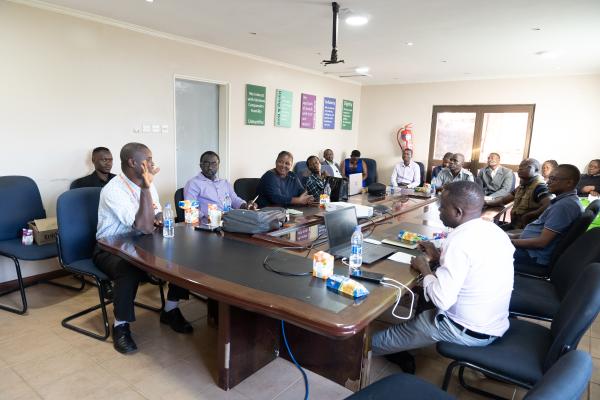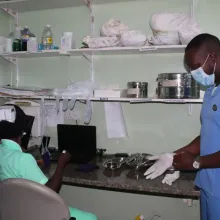Advocacy plays a vital role in building a larger community of globally minded citizens. At Partners In Health, it is our moral imperative to expose social injustice and to work toward correcting those systemic forces that create inequalities, no matter how impossible or challenging the task may appear to be. Optimism and action are part of our DNA, and why we have made a global impact.
Below are resources shared by Nick Seymour, PIH’s manager of grassroots strategy, to help you learn about and advocate for health care for all.
Take Action
1. Spread the word about global health equity.
Share a story over coffee with a friend. Pass along an inspiring book or film. Post about a favorite cause on social media. “Meaningful advances usually take informed and sustained involvement, but what’s beyond one person’s capacity can be achieved by bringing more values-aligned people into partnership,” says Seymour.
2. Contact your representatives and voice support for important causes.
One first step could be encouraging them to co-sponsor global health-related legislation, such as the Paul Farmer Memorial Resolution.
Dr. Paul Farmer, PIH’s late co-founder, addresses the Massachusetts State House in April 2020. © Joshua Qualls / Governor’s Press Office
3. Write a letter to the editor of your local newspaper.
This guide details the importance of such letters and gives tips on how to write one. Politicians and government agencies routinely clip and circulate such letters around their offices as proof of what matters to constituents.
“If you reference an elected official, it’s likely that your published letter will end up on their desk!” says Seymour. “Because many other constituents will have read it, the visibility pressures them to take action.”

Dr. Paul Farmer, PIH’s late co-founder, addresses the Massachusetts State House in April 2020.
© Joshua Qualls / Governor’s Press Office
4. Open browser tabs and support your favorite cause.
Tab for a Cause is a free, secure browser extension that allows you to raise money for PIH and other causes with every tab you open.
5. Volunteer in your community.
Consider social justice-minded organizations or grassroots groups such as PIH Engage, which recruits volunteers and mentors them on how to take meaningful actions in the global right to health movement. There are more than 500 members across 61 cities. Join an existing PIH Engage team or apply to start your own.

Madock Masina
Stay Informed
6. Watch How To Survive a Plague.
It is a documentary about the early years of the HIV/AIDS pandemic. Seymour finds it moving and a clear-sighted reflection on the sacrifices and losses incurred to push for treatment to advance HIV/AIDS. The film also serves as a reminder that the road to systemic change usually involves struggle, but that—ultimately—the results can be life affirming.
It’s a “deeply inspiring film about what a relatively small, but well-organized group of activists are able to accomplish when literally fighting for their lives,” says Seymour. “The film also articulates how a successful advocacy strategy requires not only rigorous evidence, but also creative public pressure.”
7. Read Why David Sometimes Wins: Leadership, Organization, and Strategy in the California Farm Worker Movement by Marshall Ganz.
The book “presents a recipe for an antidote to despair amid structural violence,” says Seymour. The book details the story of the United Farm Workers and how “rethinking relations of power can lead to structural change determined by the exploited, rather than the exploiters.”
Possibly most notable for future advocates, Ganz highlights three elements that lead to organizers’ success: motivation of the movement’s leaders, their diversity of approach, and their creative decision-making.
8. Read An Introduction to Global Health Delivery: Practice, Equity, Human Rights by Dr. Joia Mukherjee, PIH’s chief medical officer.
Seymour calls Mukherjee’s book a solid resource to become a more informed advocate for global health equity. And John Green, a bestselling author, vlogger, and PIH supporter, found it key to his own education as an advocate.
It is an “excellent overview of the forces that have created and exacerbated inequities in global health, the components of a strong health system, and programmatic and political interventions to begin to heal the wounds of racist and exploitative forces that have led to clinical and public health deserts,” Seymour says.
9. Enroll in online courses to further your education about a favorite cause.
If that entails global health, one resource is PIH Engage’s Crash Course. The self-paced, online course provides an overview of the history and current state of global health inequities, PIH’s mission and values, our theory of change, and resources to get involved with PIH Engage. Seymour explains the course is designed to “serve as a launching pad to long-term engagement in organizing for the right to health.”
Examples of Successful Advocacy
Since Partners In Health’s (PIH) inception in 1987, social justice work—which requires understanding the harm done to communities and working to remediate that harm—has played a key role in our clinical care.
Together with partners around the globe, PIH advocates for policies and practices that lead to stronger, more just health care systems in impoverished communities. From advocating for access to treatment for patients living with HIV/AIDS in the 1980s to more recently pushing for equitable access to COVID-19 vaccines, advocacy helps drive change to save lives. It takes many different forms: grassroots organizing, congressional calls and emails, fundraising events, educating the public, and more.



